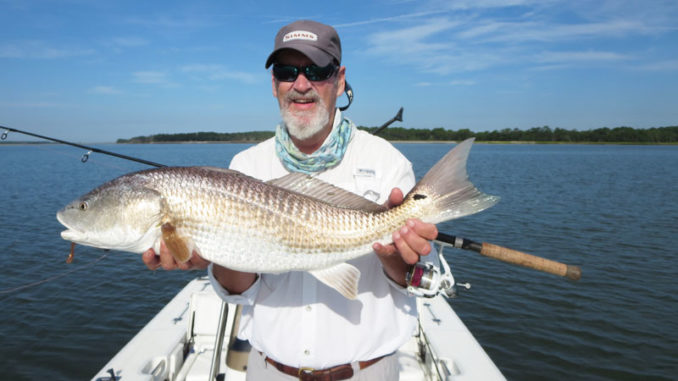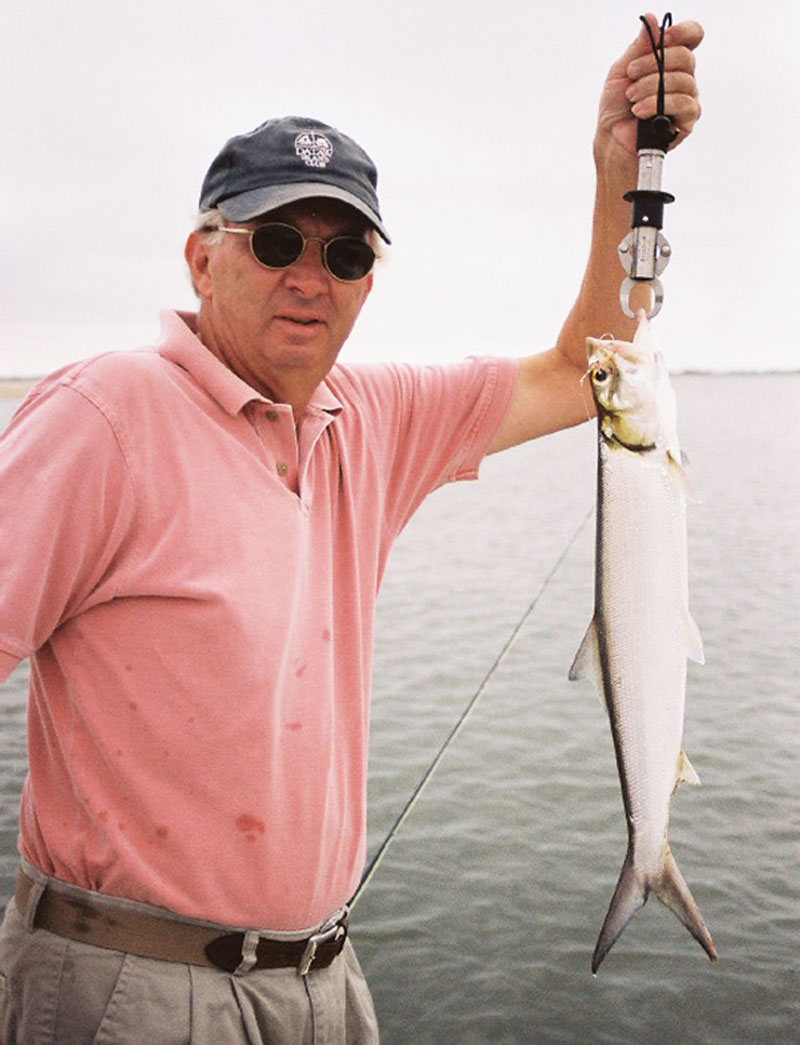
Inshore anglers all have their favorite targets, and all of them actively feed during summer in the waters around Beaufort, S.C. Cobia are still around and legal to possess in June, speckled trout feed around grass edges and oyster drops in the early and late hours, flounder have moved into their summer haunts in the creeks and inshore flats, and fun fish like ladyfish and food fish like whiting and sheepshead are around. Of course, redfish — aka spot-tails, puppy drum, red drum — the perennial favorite, are feeding aggressively in all the high- and low-tide spots.
Family fishing outings often center on finding some cooperative fish that are biting, whether the goal is landing a few keepers for supper with bait rigs or tangling with some of the sportier variety for the pure joy of the fight. The best summer advice is to remain flexible. If you start out floating a baited cork rig for flounder and they aren’t biting, you may have to try a bottom rig for whiting or even small sharks. Find something that’s biting and have fun.
Redfish are a favorite target, and in the warm, summer water, they feed aggressively on mullet, fiddler crabs, shrimp and mud minnows on all stages of the tide. Tuck Scott, head guide of Bay Street Outfitters in Beaufort said, “The schools are still on the low-tide flats but more loosely congregated.”
Scott likes targeting reds on points, mud flats and oysters with mud minnows on a cork with his bait fishermen, or ¼-ounce jigs with a Gulp paddletail trailer for his spinning tackle clients. He opts for lighter colors until the water turns murkier, and then he goes darker. For artificials, he likes the MirrODine twitch bait that suspends from 6 inches to 2 feet deep, where most redfish are caught.
By June, there are plenty of redfish moving through the deep grass with the rising water, and Tuck targets them in open pockets and then follows them on to high-tide flats when there is enough water to pole the boat.
The cold weather of this past winter severely reduced the number of trout in Lowcountry waters. Trout will be around, but they will be tough to find this month. The fish that survived cold-stun events will be in deeper water and best targeted at half-tide and rising by focusing on structure such as bridge pilings, rocks, fallen trees and shell banks that reach out from points. Trout like cleaner, moving water, not silted up with mud and sand. Popping corks and large, 3- to 5-inch finger mullet or very large mud minnows strung onto No. 3/0 Kahle hook are an excellent setup for trout, which the S.C. Department of Natural Resources is encouraging anglers to release this summer.

Fishermen who focus on fun fish like the ladyfish or the often-maligned Spanish mackerel are thrill-seekers. Ladyfish show up in shallow water around points and oyster banks and will slash at most any artificial lure or fly with abandon, often missing the hook the first time but returning for a second try. When hooked, they put on an aerial show reminiscent of tarpon in the Florida Keys, leaping skyward, shaking their head and body violently the instant they feel the jab of cold steel and often throwing the hook before they land in the water. They are fun, but don’t keep them unless you need crab bait.
Normally found in deeper water along current lines, Spanish mackerel ravage bait in schools, often frothing the water with their exuberance. Tie on a jigging spoon with a piece of wire leader and cast into their midst. It’s hard to miss.
At the other end of the spectrum are the food fishermen who target bottomfish like whiting or spot by soaking small chunks of fresh shrimp or worms on small hooks. On any given June weekend, near Trenchard’s Inlet and other similar venues, a half-dozen or more small boats, jammed with friends, will be targeting whiting on the edge of a channel drop-off nearer to the ocean. Spot are generally found in more shallow water, in estuaries with sand or muddy bottoms. These little, 8-inch fish are plentiful and easy to catch if you find them. Whiting are often filleted and fried, while spot are often fried whole like bream. Both whiting and spot are excellent food fish.
Sheepshead, the fish with the vertical, black stripes and big front teeth, are excellent-eating fish targeted from piers, dock pilings and riprap. They are notorious for stealing bait from fishermen with slow reactions. The active fishery is in the summer, with concentrations in shallow water after their migration inshore from deeper water. The most-popular bait is a fiddler crab, but small pieces of clam or shrimp should also work. Scott likes to target them around the pilings of newer docks.
Of course, the likely favorite food fish is flounder, which are target on shallow sand or mud flats, around creek mouths and all sorts of bottom structure including shell, rocks and around riprap. A jighead and trailer is often chosen for casting to flounder, or a bottom rig with. Drag or drift likely areas repeatedly, because flounder are ambush predators that attack bait swimming close by, and they tend not to chase too far. Blind-casting under docks or near rock riprap walls can also produce strikes.
If all the fish in the sea seem to be avoiding you, sharks are always around to target, and catching small sharks is pretty easy. Chop off a chunk of mullet or the wing of a skate, thread it onto a big circle hook, and cast it into the water. The size of the sharks is mostly related to the depth of the water you fish. The shallows is where the bonnethead and sharpnose sharks — two of the species legal to keep and tasty to eat — roam at this time of year. Put the rod in a rod holder, sit back, relax and let the bait and circle hook do the job. A shark will eventually find it, eat it and turn away. The line will come tight as the swallowed bait slides back out of the shark’s throat and the circle hook lodges in its usual place in the corner of the shark’s mouth. When the rod starts bouncing around, simply pull it from the rod holder and hold on.
There is literally something for everyone in June in our inshore waters.
Try wading for high-water redfish
Light-tackle and fly fishermen have really jumped onto the sport of wade-fishing for spot-tails.
According to John Holbrook, a fly-casting and fly-tying instructor at Bay Street Outfitters in Beaufort, and a wade-fishing expert, said, “Redfish move onto hard-bottomed flats in greatest numbers during warm months when the rising tide floods enough water onto them.”

Tide heights vary, but generally, there will be enough water on your flat when the tide chart predicts a 7.5-foot height or more at the mouth of the Savannah River.
Holbrook describes good wading flats as having a hard bottom, short spartina grass, two or more entry and exit spots, access to deeper water and lots of fiddler crabs. Though grubbing fiddler crabs is the main reason redfish show their tails — and an important key to finding them — they also feed on small fish, shrimp and other creatures at high tide.
When redfish move onto the flats, they do announce their presence but not as obviously as some presume. Though tailing fish are the classic show, also watch for subtle signs like V-shaped wakes, called “pushes,” fleeing or popping bait, and nervous water.
“And don’t forget to keep looking behind you for fish that sneak by,” Holbrook said.
Once you spot fish, getting in casting range without spooking them is a challenge. Whether you shuffle slowly or move aggressively, once your wake reaches the fish, they will spook.
All flies and lures need to be weedless. Once within range, cast well ahead of moving fish but right in front of tailing fish. The redfish strike in shallow water is an unmistakable swirl.
Keep your lure on the move for better results
A huge key to catching predatory gamefish in shallow water with lures or flies is keeping your offering on the move. Whether you are targeting redfish, bonefish, speckled trout, striped bass or any aggressive feeder, a lure cannot simply plop into the water and sit there on a limp line. To look alive, it must move.
The rule does not apply to deep-water presentations where free-dropping lures often draw strikes or with surface poppers where a twitching lure can tempt ferocious attacks.

Learning a simple technique that has your lure arrive at the target on an almost tight line and then move almost immediately will make you catch more fish. With open-faced spinning reels, distance control is fine-tuned by fingering the spool. To achieve the desired effect, snub the line firmly as the lure lands and begin slowly sweeping the rod away before re-engaging the bail. Re-engaging the bail with the reel handle allows slack in the line. Many good spin fishermen re-engage the bail manually, because it better controls line tension and reduces line twist.
Fly-rodders face a different challenge, but the goal of moving the fly immediately after it lands remains the same. Here, the technique involves pointing the rod directly at the target as the fly lands and making one long strip to remove all the slack. Then, while keeping the rod still and pointed at the target, continue stripping at whatever speed is appropriate for the bait you are imitating. The initial, long strip tightens the line, moves the lure a little and puts you in the correct position for the strike.
Very few aggressive fish strike motionless objects. In shallow water, move your lure right away and catch more fish.
DESTINATION INFORMATION
- HOW TO GET THERE — The Beaufort/Port Royal area is easily accessed from I-95 or US 17 via US 21 and SC 170. The Chechessee River landing at the foot of the SC 170 bridge is a popular access for much of the area. The Sands Landing in Port Royal puts you close to Paris Island spots, and Sam’s Point Landing on Lady’s Island is great access to the waters around Beaufort. Trenchard’s inlet is most easily accessed from Station Creek Landing on St. Helena Island.
- WHEN TO GO — June is an excellent month; fish whenever you have the opportunity. Plenty of fish will bite at any stage of the tide this month.
- FISHING INFO/GUIDES — Richard Sykes, 843-838-2245; Tuck Scott, 843-271-5406; Owen Plair, 843-368-3656; Shannon O’Quinn, 843-368-1558; Jack Brown, 843-838-9369; Bay Street Outfitters, Beaufort, 843-524-5250; Boat and Dock Supply, Port Royal, 843-986-0552. See also Guides & Charters in Classifieds.
- ACCOMMODATIONS — Beaufort Area Chamber of Commerce, 843-986-5400.
- MAPS — iCapt. Segull’s Nautical Charts, 888-473-4855, www.captainsegullcharts.com; Top Sport Map N233 (available at most local tackle shops).

